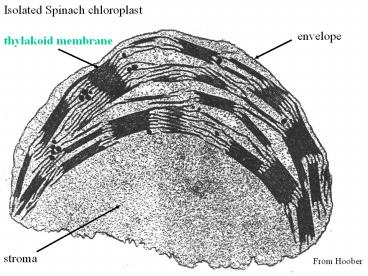Monocistronic vs Polycistronic Genes - PowerPoint PPT Presentation
Title:
Monocistronic vs Polycistronic Genes
Description:
Isolated Spinach chloroplast envelope thylakoid membrane stroma From Hoober Chloroplast RNA polymerases (RNAPs) Two different RNAPs in vascular plant chloroplasts ... – PowerPoint PPT presentation
Number of Views:1445
Avg rating:3.0/5.0
Title: Monocistronic vs Polycistronic Genes
1
Isolated Spinach chloroplast
envelope
thylakoid membrane
stroma
From Hoober
2
Chloroplast RNA polymerases (RNAPs)
- Two different RNAPs in vascular plant
chloroplasts - Bacterial-like polymerase (also called PEP,
plastid-encoded polymerase) - Phage-like or NEP (nuclear-encoded polymerase)
polymerase
3
Chloroplast Bacterial-like RNAP
- Inhibited by Rifampicin
- composed of Core Sigma factor
- Core 4 subunits, ?2 ? ?'
- ? (rpoA)
- ? (rpoB gene is sometimes split)
- ?' (rpoC1 and rpoC2)
- Sigma factor (recognizes -10, -35 promoters)
- Nuclear-encoded, 6 genes in Arabidopsis (3 of
which have non-overlapping targets)
4
Chloroplast phage-like polymerase (NEP)
- Similar to 1-subunit phage RNA polymerases
- Nuclear gene(s)
- Enzyme insensitive to rifampicin
- Recognize promoter of 7-10 bp
- Specificity factor not yet identified
5
Some chloroplast genes have promoters for both
the PEP and NEP RNAPs..
Fig. 6.31 in Buchanan et al.
6
Why is chloroplast transcription much more
complex than mitochondrial transcription?
Chloroplasts are larger, more complex organelles,
that differentiate.
7
Chloroplasts are a type of Plastid
- 1. Proplastids precursor form, in meristems
- 2. Etioplasts - in shoots of dark-grown plants
- 3. Chloroplasts - green tissues
- 4. Amyloplasts - prominent in roots, store
starch, colorless - 5. Chromoplasts - mature fruit, carotenoids
8
From U. Wisconsin Botany Dept.
9
Plastid types develop from proplastids Shoots
light-gt proplastids lt----gt etioplasts
lt----gt chloroplasts chromoplasts
Roots proplastids lt----gt amyloplasts
10
Complex suite of RNAPs provides for developmental
regulation.
- NEP more important in proplastids (needed to make
the rpo genes). - PEP more important in chloroplasts.
- PEP also regulated by sigma factors
- - selective transcription by different sigma
genes - - phosphorylation of sigmas
11
Monocistronic and/or Polycistronic Transcription
- Prokaryotes Both
- Eukaryotes
- Nucleus Monocistronic (polycistronic rare)
- Mitochondria
- Mammals Polycistronic (2 promoters)
- Other lower species Both
- Plastids - Both
12
Transcription in the Eukaryotic Nucleus
- RNA Polymerases
- Promoters for each polymerase
- General transcription factors
- Regulatory factors and combinatorial regulation
13
Studies of RNA synthesis by isolated nuclei
- RNA synthesis by isolated nuclei indicated that
there were at least 2 polymerases one of which
was in the nucleolus and synthesized rRNA - rRNA often has a higher G-C content than other
RNAs a G-C rich RNA fraction was preferentially
synthesized with low ionic strength and Mg2 - Another less G-C rich RNA fraction was
preferentially synthesized at higher ionic
strength with Mn2
14
Roeder and Rutters separation of 3 nuclear RNA
polymerases from sea urchin embryos by ion
exchange chromatography on DEAE-Sephadex
Fig. 10.1
15
Nucleoplasmic fraction enriched in Pol II
Nucleolar fraction- Enriched in Pol I
Fig. 10.2
16
Determining Roles for Each Nuclear RNA Polymerase
(nRNAP)
- Purified polymerases dont transcribe DNA
specifically so used nuclear fractions. - Also useful were two transcription inhibitors
- a-aminitin from a mushroom, inhibits RNAP II,
and RNAP III at higher concentrations. - Actinomycin D - general transcription inhibitor,
binds DNA and intercalates into helix, prefers
G-C rich regions (like rRNA genes).
17
Fig. 10.3
a aminitin, from Amanita phalloides (death cap
mushroom).
18
Actinomycin D, from Streptomyces
Intercalating Portion.
19
RNA Polymerase I
- Not inhibited by aminitin, but inhibited by low
concentrations of actinomycin D. - RNA produced in the presence of a-aminitin could
be competed by rRNA for hybridization to (rat)
DNA. - Conclusion nRNAP I synthesizes the rRNA
precursor (45S pre-rRNA ? 28S 18S 5.8S rRNAs)
20
RNA Polymerase II
- Actinomycin D, at low concentrations, did not
inhibit synthesis of heterogenous nuclear RNA (hn
RNA). - a-aminitin inhibited synthesis of hnRNA in
nucleoplasmic fraction. - Conclusion nRNAP II synthesizes hnRNA (mostly
mRNA precursors).
21
RNA Polymerase III
- Synthesis of small abundant RNAs inhibited only
at high a-aminitin - Small RNAs tRNA precursors, 5S rRNA, U6
(involved in splicing), and 7SL RNA (involved in
protein secretion through the ER, part of the
signal recognition particle). - Conclusion nRNAP III synthesizes many of the
small abundant cytoplasmic and nuclear RNAs
22
(No Transcript)
23
Subunit structure of purified nRNAPs
- All 3 have 10-14 subunits.
- Subunits range from 8 to 220 kDa.
- All 3 have 2 very large (gt125 kD) subunits and
several smaller ones. - Several of the smaller subunits (5 in yeast) are
common to all 3 RNAPs.
Human RNAP II, Table 10.2































